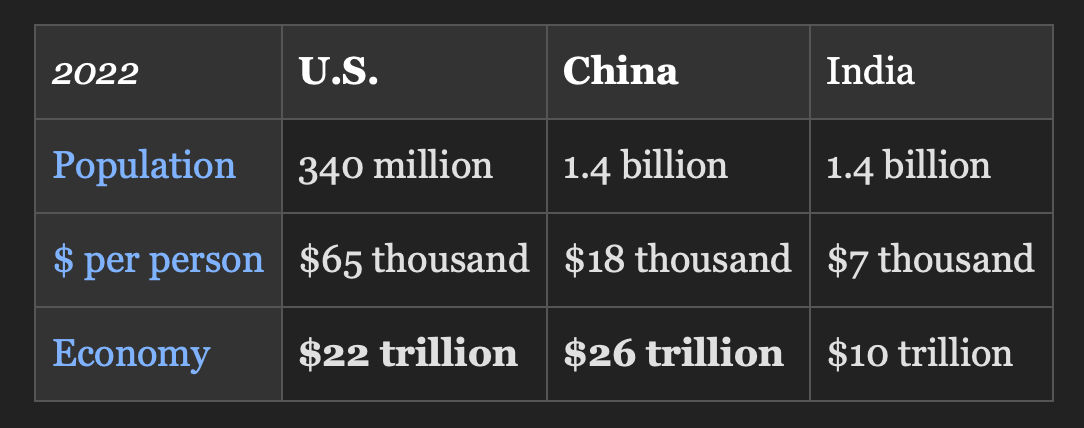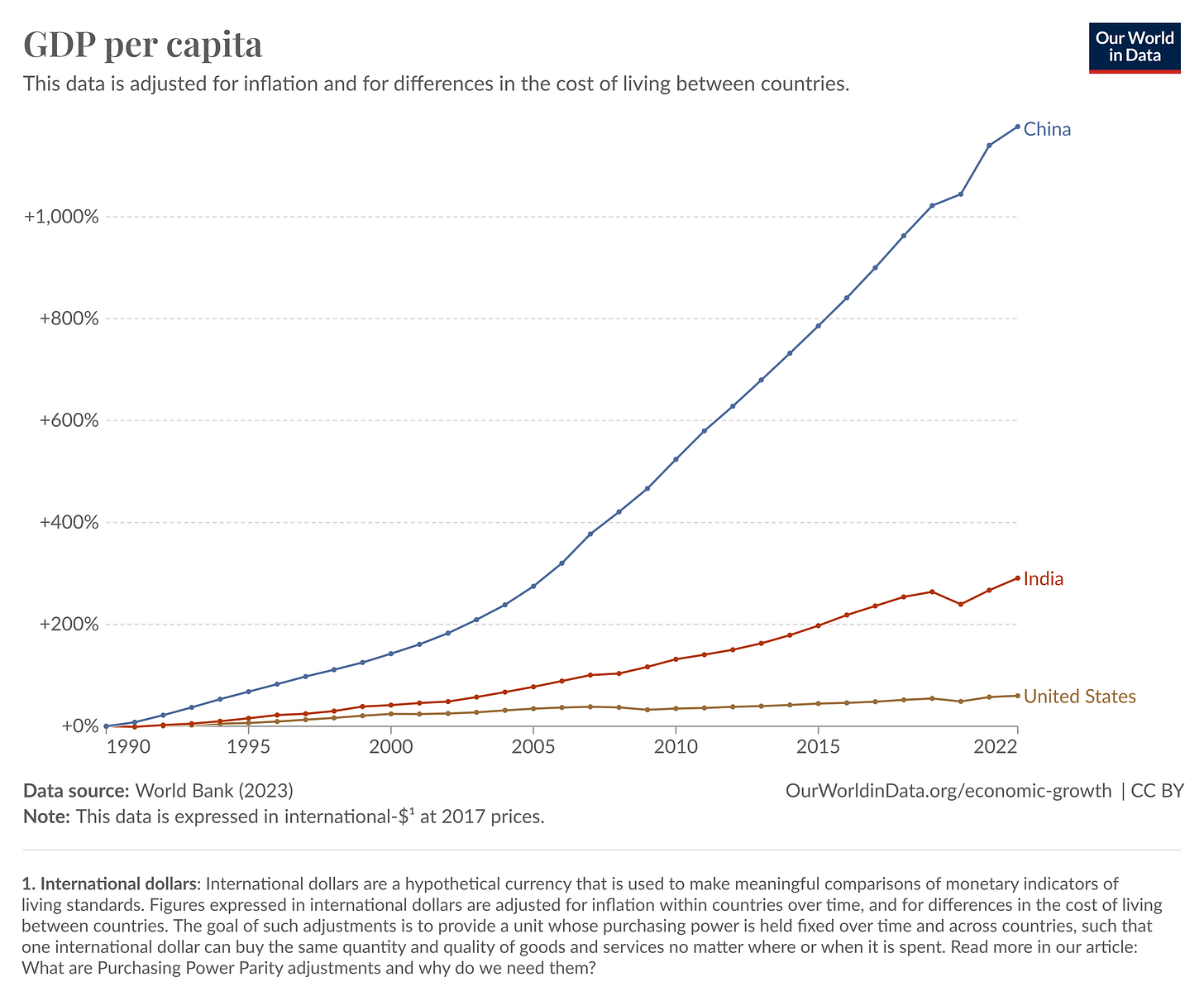A U.S.-China tech tie is a big win for China because of its population advantage
China’s population is declining, but UN projections show it will remain at least twice the size of the U.S. for decades.

So what?
Population size matters because economy size (GDP) matters and GDP = population × output per person. For example:
100 million people × $50,000 per year = a $5 trillion economy
1 billion people × $50,000 per year = a $50 trillion economy
Then why hasn’t China’s economy already dwarfed America’s?
It’s because China’s output per person is still much lower than America’s. China has about 4× the people but about ¼ the output per person. 4 × ¼ = 1. This means that by any standard GDP measure, such as market exchange rates or Purchasing Power Parity, the two economies are in the same ballpark today.

OK, but why is China’s economic output per person so much lower than America’s?
A primary reason is that large swaths of its workforce aren’t yet at the technological frontier. About 23% of Chinese workers are in agriculture vs. about 1½% in the U.S. However, if China continues to educate its population, mechanize its workforce, and diffuse technology across it, that gap will continue to narrow and per-worker output will continue to climb. Only a decade ago, over 30% of China’s workforce was in agriculture, and per-person output has grown much faster than in the U.S. for decades.
Technology is the driving force enabling China to catch up with the U.S. in economic output per person. As long as China diffuses increasingly sophisticated technology through its workforce significantly faster than in the U.S., then it will keep raising output per person relative to the U.S., growing its economy faster. Diffusion is not automatic; it depends on continued private-sector dynamism and sound policy. It isn’t guaranteed, but it is certainly plausible, if not likely.
Put another way, a U.S.-China tech tie is a big win for China because of its population advantage. China doesn't need to surpass us technologically; it just needs to implement what already exists across its massive workforce. Matching us is enough for its economy to dwarf ours. If per person output were equal today, China’s economy would be over 4× America’s because China’s population is over 4× the U.S. That exact 4× outcome is unlikely given China’s declining population and the time it takes to diffuse technology, but 2 to 3× is not out of the question. China doesn't even need to match our per-person output: their population will be over 3× ours for decades, so reaching ⅔ would still give them an economy twice our size since 3 × ⅔ = 2.
Some may recall similar predictions about Japan in the 1980s that never materialized. But China is fundamentally different: Japan's population peaked at less than ½ the U.S., while China's is over 4× ours. Japan’s workforce had already reached the technological frontier when it stalled out, while China is still far behind with massive room to catch up.
And what does China win exactly?
China wins a much bigger economy. With an economy a multiple of the U.S., it’s much easier to outspend us on defense and R&D, since budgets are typically set as a share of GDP. Once China’s economy is double or triple ours, trying to keep up would strain our economy and risk the classic guns-over-butter trap. (This is the same trap that contributed to the Soviet Union’s collapse: too much of its economy steered toward military ends.) Alliances could help offset raw population scale, but only if we coordinate science, supply chains, and procurement, which we have not achieved at the needed scale.
What if China then starts vastly outspending us on science and technology and becomes many years ahead of us in future critical technologies, such as artificial superintelligence, energy, quantum computing, humanoid robots, and space technology? That’s what the U.S. was to China just a few decades ago, and China runs five-year plans that prioritize science and technology.
What can we do about it?
Our current per person output advantage is not sustainable unless we regain technological dominance. By dominance, I don’t mean a few months ahead like today’s AI cycles. I mean many years ahead in developing, diffusing, and commercializing frontier science and technology.
My takeaway: we need to recognize how quickly we are losing our privileged position to China. If its economy doubles or triples ours, it can outspend us to lock in technological and military dominance. That may not happen, but we shouldn’t bet on it. Instead, we should materially increase effective research funding and focus on our own technology diffusion plans to upgrade our jobs and raise our living standards.
What about AI automation?
The net job effect of AI automation is hotly debated, but any outcome doesn’t change this calculus. If employment levels remain about the same then the status quo population advantage remains. If net jobs drop dramatically due to an AI-dominated economy, staying ahead in AI systems becomes even more important. So, either way, doing more effective research and development is critical.
This should be the most important and bipartisan political issue. Research and technology diffusion isn’t everything, but it is the cornerstone of future prosperity. If we don’t get it right, we definitely lose, and we’re currently not getting it right.



Great post esp. if you consider the current numbers with the E.U. as a major player. Really the very last chance to keep track with China and the US as the top 3 global economic players.
https://www.perplexity.ai/search/latest-gdp-numbers-of-germany-totqCyrHTKaZO5el4csKCg#1